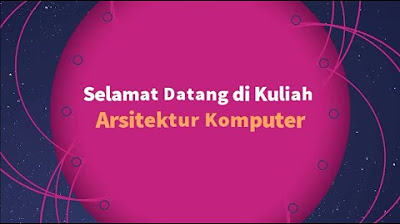The computer processing cycle or Information processing cycle
Summary
TLDRThe information processing cycle is a core concept in computer science, detailing how computers operate. It includes four key stages: input, where data is gathered via devices like keyboards and sensors; processing, where the CPU executes instructions to manipulate data; output, where results are presented through devices like monitors or speakers; and storage, where processed data is saved for future use. This cyclical process allows computers to continuously handle new or existing data, enabling efficient and accurate computing tasks.
Takeaways
- 💻 The computer processing cycle, also called the information processing cycle, consists of key steps that a computer follows to operate.
- 🖱️ Input involves collecting data from external sources using devices like keyboards, mice, scanners, and sensors.
- 🔢 The data input can be in various forms such as text, numbers, images, sounds, and videos.
- ⚙️ Processing is when the computer manipulates the input data based on predefined instructions using the CPU.
- 🧮 Processing tasks can include calculations, comparisons, data transformations, and other operations.
- 🖥️ Output is the stage where the processed data is presented in human-readable form using monitors, printers, speakers, and other devices.
- 📊 Output can include different forms such as text, graphics, audio, video, or physical actions.
- 💾 Storage is the final step where the processed data is saved on devices like HDDs, SSDs, or USB drives for future use.
- 🔄 The processing cycle is iterative, meaning the computer can repeat the cycle with new input or continue processing existing data.
- ⚡ This cyclical process is fundamental for computing and allows computers to perform tasks efficiently and accurately.
Q & A
What is the Information Processing Cycle?
-The Information Processing Cycle refers to the sequence of steps a computer follows to receive input, process it, produce output, and store the results. It is fundamental to understanding how computers operate.
What are the four main stages of the Information Processing Cycle?
-The four main stages are: Input, Processing, Output, and Storage.
What occurs during the 'Input' stage of the Information Processing Cycle?
-During the Input stage, the computer gathers data or instructions from external devices like keyboards, mice, touchscreens, microphones, scanners, and sensors. This data can take various forms such as text, numbers, images, sound, and video.
Which devices are used for input in a computer system?
-Devices such as keyboards, mice, touchscreens, microphones, scanners, and sensors are used to input data into a computer system.
What is the role of the Central Processing Unit (CPU) during the Processing stage?
-The CPU processes the input by executing instructions and performing arithmetic and logical operations on the data. It manipulates the data according to predefined algorithms stored in the computer's memory.
What types of operations might be involved in the Processing stage?
-The Processing stage may involve calculations, comparisons, data transformations, or other operations depending on the nature of the task.
What happens in the 'Output' stage of the Information Processing Cycle?
-In the Output stage, the computer produces human-readable results from the processed data. Devices such as monitors, printers, speakers, and actuators are used to present the information in forms such as text, graphics, audio, or video.
Can you name some output devices that are used to present processed information?
-Output devices include monitors, printers, speakers, and actuators.
What is the purpose of the 'Storage' stage in the Information Processing Cycle?
-The Storage stage involves saving processed data for future use on storage devices like hard disk drives (HDDs), solid-state drives (SSDs), USB flash drives, magnetic tapes, or optical discs.
How is the Information Processing Cycle continuous?
-The cycle is continuous and iterative, meaning after completing one cycle, the computer can start a new cycle with new input or continue processing existing data, allowing for efficient and accurate performance of tasks.
Outlines

Cette section est réservée aux utilisateurs payants. Améliorez votre compte pour accéder à cette section.
Améliorer maintenantMindmap

Cette section est réservée aux utilisateurs payants. Améliorez votre compte pour accéder à cette section.
Améliorer maintenantKeywords

Cette section est réservée aux utilisateurs payants. Améliorez votre compte pour accéder à cette section.
Améliorer maintenantHighlights

Cette section est réservée aux utilisateurs payants. Améliorez votre compte pour accéder à cette section.
Améliorer maintenantTranscripts

Cette section est réservée aux utilisateurs payants. Améliorez votre compte pour accéder à cette section.
Améliorer maintenant5.0 / 5 (0 votes)






